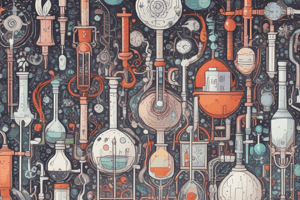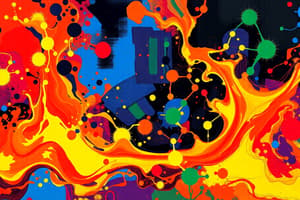Podcast
Questions and Answers
Which of the following observations does NOT necessarily indicate that a chemical reaction has taken place?
Which of the following observations does NOT necessarily indicate that a chemical reaction has taken place?
- Change in shape (correct)
- Change in color
- Change in state
- Evolution of a gas
A balanced chemical equation has the same number of each type of atom on both sides of the equation.
A balanced chemical equation has the same number of each type of atom on both sides of the equation.
True (A)
In a chemical equation, what does the symbol '(aq)' represent?
In a chemical equation, what does the symbol '(aq)' represent?
aqueous solution
Reactions that release heat along with the formation of products are called ______ reactions.
Reactions that release heat along with the formation of products are called ______ reactions.
Match the type of reaction with its description:
Match the type of reaction with its description:
In the reaction $CuO + H_2 \rightarrow Cu + H_2O$, which substance is being reduced?
In the reaction $CuO + H_2 \rightarrow Cu + H_2O$, which substance is being reduced?
Rusting of iron is an example of corrosion.
Rusting of iron is an example of corrosion.
What is rancidity, and what causes it?
What is rancidity, and what causes it?
Substances that prevent oxidation are called ______.
Substances that prevent oxidation are called ______.
Why is it important to balance chemical equations?
Why is it important to balance chemical equations?
Decomposition reactions involve two or more reactants combining to form a single product.
Decomposition reactions involve two or more reactants combining to form a single product.
Provide an example of a reaction where heat is supplied in the form of electricity.
Provide an example of a reaction where heat is supplied in the form of electricity.
A ______ reaction is one in which energy is absorbed.
A ______ reaction is one in which energy is absorbed.
Which type of reaction is used in black and white photography?
Which type of reaction is used in black and white photography?
Match the following terms with their meaning in reference to chemical reactions:
Match the following terms with their meaning in reference to chemical reactions:
In the reaction $Zn(s) + CuSO_4(aq) \rightarrow ZnSO_4(aq) + Cu(s)$, which element is displaced?
In the reaction $Zn(s) + CuSO_4(aq) \rightarrow ZnSO_4(aq) + Cu(s)$, which element is displaced?
The formation of a precipitate indicates a displacement reaction has occurred.
The formation of a precipitate indicates a displacement reaction has occurred.
What is the chemical formula for quick lime?
What is the chemical formula for quick lime?
The black coating that forms on silver is due to ______.
The black coating that forms on silver is due to ______.
What is the purpose of cleaning a magnesium ribbon with sandpaper before burning it?
What is the purpose of cleaning a magnesium ribbon with sandpaper before burning it?
Flashcards
What is a chemical reaction?
What is a chemical reaction?
A process involving rearrangement of atoms and molecules to form new substances.
What are reactants?
What are reactants?
Substances that undergo chemical changes in a reaction.
What are products?
What are products?
New substances formed as a result of a chemical reaction.
What is a chemical equation?
What is a chemical equation?
Signup and view all the flashcards
What is a skeletal equation?
What is a skeletal equation?
Signup and view all the flashcards
What is conservation of mass?
What is conservation of mass?
Signup and view all the flashcards
What is a balanced chemical equation?
What is a balanced chemical equation?
Signup and view all the flashcards
What is a combination reaction?
What is a combination reaction?
Signup and view all the flashcards
What is a decomposition reaction?
What is a decomposition reaction?
Signup and view all the flashcards
What is an exothermic reaction?
What is an exothermic reaction?
Signup and view all the flashcards
What is an endothermic reaction?
What is an endothermic reaction?
Signup and view all the flashcards
What is a displacement reaction?
What is a displacement reaction?
Signup and view all the flashcards
What is a double displacement reaction?
What is a double displacement reaction?
Signup and view all the flashcards
What is a precipitation reaction?
What is a precipitation reaction?
Signup and view all the flashcards
What is oxidation?
What is oxidation?
Signup and view all the flashcards
What is reduction?
What is reduction?
Signup and view all the flashcards
What is a redox reaction?
What is a redox reaction?
Signup and view all the flashcards
What is corrosion?
What is corrosion?
Signup and view all the flashcards
What is rancidity?
What is rancidity?
Signup and view all the flashcards
Study Notes
- A chemical equation represents reactants, products, and their physical states.
- Chemical equations must be balanced, ensuring the same number of atoms for each element on both sides.
Combination Reactions
- Two or more substances combine into a single new substance.
- Example: Burning of coal, C(s) + O2(g) → CO2(g)
Decomposition Reactions
- A single substance breaks down into two or more substances.
- This is the opposite of combination reactions.
- Example: Ferrous sulphate crystals decomposition, 2FeSO4(s) → Fe2O3(s) + SO2(g) + SO3(g)
Exothermic Reactions
- Reactions release heat along with the products.
- They warm the surrounding environment.
- Example: Burning of natural gas, CH4(g) + 2O2(g) → CO2(g) + 2H2O(g)
Endothermic Reactions
- Reactions absorb energy.
- Example: Barium hydroxide with ammonium chloride.
Displacement Reactions
- An element displaces another element in a compound.
- Example: Iron displacing copper, Fe(s) + CuSO4(aq) → FeSO4(aq) + Cu(s)
Double Displacement Reactions
- Two different atoms or groups of atoms (ions) are exchanged.
- Example: Sodium sulfate with barium chloride, Na2SO4(aq) + BaCl2(aq) → BaSO4(s) + 2NaCl(aq)
Precipitation Reactions
- Reactions produce insoluble salts, forming a precipitate.
- Barium chloride and sodium sulfate react to give barium sulfate which is a precipitate
Oxidation
- A substance gains oxygen.
- A substance loses hydrogen.
- Example: Copper turning into copper oxide, 2Cu + O2 → 2CuO
Reduction
- A substance loses oxygen.
- A substance gains hydrogen.
- Example: Zinc oxide reacting with carbon, ZnO + C → Zn + CO
Redox Reactions
- Oxidation and reduction occur simultaneously.
- Example: Copper oxide reacting with hydrogen, CuO + H2 → Cu + H2O
Effects of Oxidation Reactions
- Corrosion occurs when metals are attacked by substances like moisture and acids.
- Rusting of iron produces a reddish-brown powder coating.
- Rancidity develops in fats and oils due to oxidation, causing a smell and taste change.
- Antioxidants and airtight containers slow down oxidation.
- Nitrogen gas is used to flush bags of chips.
Studying That Suits You
Use AI to generate personalized quizzes and flashcards to suit your learning preferences.




